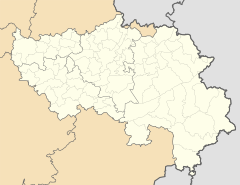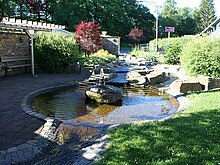Deidenberg
| Deidenberg | ||
|---|---|---|
|
|
||
| State : |
|
|
| Region : | Wallonia | |
| Province : | Liege | |
| District : | Verviers | |
| Coordinates : | 50 ° 21 ′ N , 6 ° 8 ′ E | |
| Residents: | 523 pop. | |
Deidenberg is a village in the municipality of Amel in the German-speaking Community of Belgium . With 523 inhabitants (January 2016) Deidenberg is the third largest village in the municipality (after Amel and Born).
Deidenberg is two kilometers west of the Amel town center, immediately south of the Amel River .
history
On the gently rising hills of the Amel valley lies the village of Deidenberg, which, with its rural character and the surrounding forests, reflects the typical landscape of the high plateau of the Ardennes.
Even if the village was probably created during the migration of peoples in the early Middle Ages (the ending "-berg" indicates a foundation between 600 and 800 AD), some archaeological monuments and field names point to an earlier settlement. For example, the field name “Tömmel” (from the Latin “tumulus”) is evidence of a settlement from Roman times. On the tranchot map from the French period around 1800 this survey is called "Thümmelsberg", the Prussian cadastre from 1827 names the names "Am Tömmel" and "Aufm Tömmel". These names suggest that a burial mound existed in the past and are also a legacy from Roman times.
One of these ground monuments is the "Hülsburg" in the Schwarzenvenn at the foot of the Wolfsbusch, between the villages of Born, Deidenberg and Montenau. The "Wolfsbusch", formerly also called "Wolfsberg", extends to the west of Deidenberg. In the time of Maria Theresa this was divided among the neighboring villages of Montenau, Deidenberg, Born, Iveldingen, Schoppen and Eibertingen. The Hülsburg is mentioned for the first time by Michel Bormann (1795–1860) in the 2nd volume of his work “Contribution to the history of the Ardennes (1842)”. He describes it as a chain of trenches at the edge of the forest, which were probably used for defense. Unfortunately, only a few remains of these trenches can be seen today. The other is the Roman villa, which was between Deidenberg and Montenau. Excavations took place here in the 1860s, carried out by Dr. Hecking. The remains of the villa in Kautenbusch were 70 m long and 22–30 m wide. During further excavations in 1925, clay tiles of the heating system and fragments of the colored plaster were found. Even if the excavations were not completed, the remains that have been found indicate a large settlement complex.
Deidenberg was first mentioned in 1455 in a document in which Count Johann Nassau gave "Diedenberh" as a fief to Johan von Herdorf. In the list of fireplaces from 1501 Deidenberg is given as 9 fireplaces. In Pastor Huart's notebook from 1681 there are 12 houses listed for Deidenberg, in another register of the Amel parish from 1767 27 houses are listed. The Ferrari map also dates from this time. It was created on the initiative of the Austrian Lieutenant General von Ferraris in the years 1771–1777. This map shows the Austrian Netherlands, to which Deidenberg belonged at the time, and was commissioned by Maria Theresa.
The old chapel, which was built in 1707 and which was located opposite the "old school" in the center of the village, turned out to be too small and in 1949 it was decided to build a new church. However, it was not until the 1st Sunday of Advent in 1961 before Bishop Wilhelm-Maria van Zuylen could inaugurate the new church, which is dedicated to the Holy Family. According to the plans of the architect Georges Lambeau, it was built within 2 years from hewn arkose stones from the neighboring quarries in Ondenval. In the interior there are still two wooden figures from the old chapel: St. Germanus, Bishop of Auxerre, u. St. Isidore with the ox (2nd patron saint). Also worth mentioning is the rather atypical construction of a separately standing bell tower (campanile). In memory of the old chapel, a frame with a 130 kg bell was attached in front of the tower, which was cast in Saarbrücken in 1864. was consecrated to St. Isidore. By decree of the governor Baltia of September 9, 1924 Deidenberg was affiliated with the parish Amel.
The "old school" was built in 1850 and enlarged in 1921. In 1952 it was obsolete because the new elementary school behind the church was completed and is still in service today. The interior of the "old school" was completely renovated in 2017-2018 in cooperation with the German-speaking Community, the Amel community and the Friends' Association. It is used extensively by the village associations and senior citizens and can be rented for weekend events, youth camps and seminars.
regional customs
The parade and the cap meetings lure fools from near and far to Deidenberg and made it one of the strongholds of the Eifel Carnival. Responsible for this are the “Degdeberjer Tünnesse”, who have been able to call themselves “royal” since 2014 (founded in 1964). In addition, a generally lively club activity enriches the village's leisure time activities: Musikverein Montenau-Iveldingen-Deidenberg, Born-Deidenberg church choir, women's singing group ("The Old School Singers"), power women, Möhnen, bachelor club, parents' association, cards, darts and others. Bowling club, indoor soccer, development association, etc.
tourism
The two campsites “Oos Heem” and “Euro Mini Camping” as well as the hall of the KKG Deidenberg or the “Old School” (landlord: Förderverein) offer overnight accommodation. Tourists can also stop off at the two restaurants in the village.
literature
- Klaus Dieter Klauser, Günther Schneider, Michel Bormann: Monthly issues of the history and museum association “Between Venn and Schneifel” . 50 years church Deidenberg - contribution to the history of the Ardennes. 1842, ZDB ID 512962-X .
- Günther Schneider: 50 years of Deidenberg Church .
- Michel Bormann: Contribution to the history of the Ardennes . 1842.



